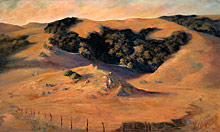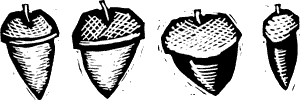Docent Circle: Field Notes Week of 2005-09-19

Indian Summer, the most typically "American" of all seasons,
has also been called Late Summer, Sham Summer, the Fifth Season, All
Hallow's Summer, Red Man's Summer and Smoke Season. Legend has it
that Indian Summer was so named because of the atmospheric haze
present at this time, and that pioneers associated it with Indian war
fires. This was actually the season when Indians began to prepare for
winter hunting and food gathering. The fires that created smoke
historically were most likely used to scare game into traps or groups
of hunters. The blue haze of Indian Summer is caused by salt
particles within the air that settle during the autumnal change of
high-altitude prevailing wind patterns. (adapted from Eric Sloane's,
The Seasons of America Past)
What is going on with the birds? Nesting season has ended and
juvenile birds are flocking and feeding in mixed groups. Don't be
surprised to see house finches with nuthatches or groups of chestnut
backed chickadees with bushtits and juncos. Many birds, if they
haven't left for their fall migration, are here to fatten up before
making a long journey south. The swallows left us to winter in South
America, several weeks ago.
 One exception to the direction are the
Brown Pelicans, which disperse to the north after breeding in the
south. White Pelicans are east-west migrants and are moving through
the Laguna now. Watch for vagrants (birds with faulty compasses,
often juveniles) and other migrants (birds that are just passing
through), such as the White-Faced Ibis flock that was spotted on some
open water on the Laguna recently. If we are lucky this Fall, we will
see the stunning migration of Vaux Swifts as they move through the
Russian River watershed to the tropics of Central America. Watch for
plumage changes as males tend to lose their brilliant mate-attracting
colors in favor of a duller colored Winter wardrobe.
One exception to the direction are the
Brown Pelicans, which disperse to the north after breeding in the
south. White Pelicans are east-west migrants and are moving through
the Laguna now. Watch for vagrants (birds with faulty compasses,
often juveniles) and other migrants (birds that are just passing
through), such as the White-Faced Ibis flock that was spotted on some
open water on the Laguna recently. If we are lucky this Fall, we will
see the stunning migration of Vaux Swifts as they move through the
Russian River watershed to the tropics of Central America. Watch for
plumage changes as males tend to lose their brilliant mate-attracting
colors in favor of a duller colored Winter wardrobe.
Which birds will be leaving the Laguna for the winter? (Western
Kingbird, Black Headed Grosbeak, Red-winged blackbirds) Which birds
will come to the Laguna to spend the Winter? (White and Golden
Crowned Sparrows, Cedar Waxwings, Short-eared Owls). Think of some of
the birds that stay here all year round.
And just when the season starts winding down, fruit begins to
appear on shrubs, trees and grasses. Poison oak is covered in ripe
berries, relished by the birds. Look for snowberries (do not eat!),
honeysuckle, buckeyes, acorns, manzanita berries, rose hips, wax
myrtle and seeds of chicory, grasses, thistle, tarweed and many others
you will find in the Laguna. Animals need extra energy now and when
they store it or eat it, they are also dispersing the seeds for the
plants.
The plant can't move, but if it has fruit or, seeds that
tempt the birds, foxes, and gophers to eat them, the seeds move with
 the animal to other locations as they pass through the digestive tract
for deposit on the ground. Isn't this a perfect way for nature to
work?
the animal to other locations as they pass through the digestive tract
for deposit on the ground. Isn't this a perfect way for nature to
work?
What are other ways seeds disperse themselves? Try doing a sock walk
in the field with the kids: put an old sock over a student's shoes
before walking the trail. Count how many different types of seeds are
stuck on the socks at the end of the walk.
There are two ways to live your life. One is as though nothing is a
miracle.
The other is as though everything is a miracle.
-- Albert Einstein
Back to the Field Notes Archive

 One exception to the direction are the
Brown Pelicans, which disperse to the north after breeding in the
south. White Pelicans are east-west migrants and are moving through
the Laguna now. Watch for vagrants (birds with faulty compasses,
often juveniles) and other migrants (birds that are just passing
through), such as the White-Faced Ibis flock that was spotted on some
open water on the Laguna recently. If we are lucky this Fall, we will
see the stunning migration of Vaux Swifts as they move through the
Russian River watershed to the tropics of Central America. Watch for
plumage changes as males tend to lose their brilliant mate-attracting
colors in favor of a duller colored Winter wardrobe.
One exception to the direction are the
Brown Pelicans, which disperse to the north after breeding in the
south. White Pelicans are east-west migrants and are moving through
the Laguna now. Watch for vagrants (birds with faulty compasses,
often juveniles) and other migrants (birds that are just passing
through), such as the White-Faced Ibis flock that was spotted on some
open water on the Laguna recently. If we are lucky this Fall, we will
see the stunning migration of Vaux Swifts as they move through the
Russian River watershed to the tropics of Central America. Watch for
plumage changes as males tend to lose their brilliant mate-attracting
colors in favor of a duller colored Winter wardrobe.
 the animal to other locations as they pass through the digestive tract
for deposit on the ground. Isn't this a perfect way for nature to
work?
the animal to other locations as they pass through the digestive tract
for deposit on the ground. Isn't this a perfect way for nature to
work?